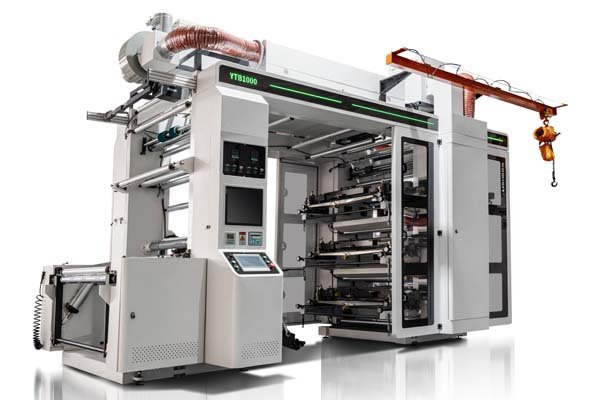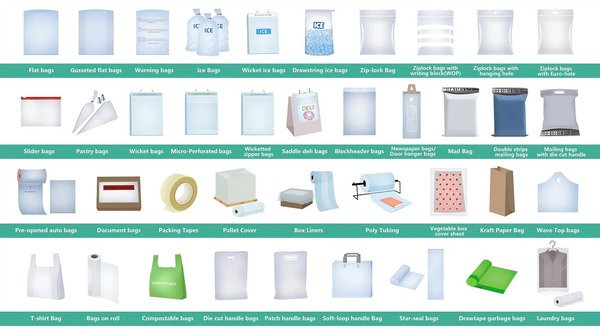
Need to print on plastic bags but unsure which machine? Choosing wrong wastes money and time. We'll explain the best options to help you decide.
We use several machines for printing on plastic bags. Flexographic and rotogravure printers are common for large orders. Screen printing1 offers design flexibility. UV printing2 is good for smaller, complex jobs.
Each of these printing methods has specific strengths. Flexography is known for its speed and efficiency in high-volume runs. Rotogravure excels in producing very high-quality, detailed images. Screen printing is versatile, allowing for thick ink application and vibrant colors on many surfaces. UV printing provides quick curing and sharp prints, making it suitable for intricate designs and faster turnaround times, especially on non-porous plastic materials. Understanding these differences helps you pick the right technology for your needs.
Flexographic printers use flexible relief plates and fast-drying inks. This makes them a cost-effective choice for long production runs. Rotogravure printing employs engraved cylinders to transfer ink. This results in exceptional print quality for premium packaging. Screen printing pushes ink through a mesh screen stencil, creating bold, opaque prints. This method is great for unusual shapes or when thick ink coverage is desired. UV printers use ultraviolet light to cure inks instantly. This means prints are immediately dry and durable, which is a big plus.
Which printing machine is best for high-volume plastic bag printing?
Thinking about large-scale plastic bag printing operations? You need a machine that can handle the volume efficiently. Let's see which types are truly up to this task.
For high-volume plastic bag printing, flexographic (flexo) and rotogravure machines are generally the best choices. Flexo offers a strong balance of speed and cost-effectiveness. Rotogravure provides superior quality for very large, consistent print runs that demand fine detail.

Decoding Flexographic Printing for Bulk Orders
We find flexo printing is a popular choice for many businesses needing bulk orders. It uses flexible photopolymer printing plates. These plates are wrapped around rotating cylinders. Ink is transferred from an anilox roller to the plate, and then onto the plastic film. It's very efficient for simple to moderately complex designs. Many of our clients appreciate its speed; some machines can print over 200 meters per minute. Some manufacturers, like those listed on [mohindramachine.com], offer flexographic printing machines that showcase this capability.
Understanding Rotogravure Printing for Mass Production
Rotogravure uses engraved metal cylinders. Each cylinder is carefully engraved with the image for one specific color. These cells are filled with ink, and any excess ink is wiped off the cylinder's surface. The plastic film then passes between an impression roller and the gravure cylinder. This action transfers the ink to the film. This method is more expensive to set up initially because of the cylinder engraving costs. However, for extremely long runs where top-tier image quality is essential, it becomes very cost-effective over time.
Key Differences: Flexo vs. Roto for High Volume
Here's a quick comparison to help you see the main differences:
| Feature | Flexographic Printing | Rotogravure Printing |
|---|---|---|
| Print Quality | Good to Very Good | Excellent, Best for Fine Detail & Photographs |
| Setup Cost | Moderate | High (due to intricate cylinder engraving) |
| Run Length | Medium to Very Long | Very Long (often millions of impressions) |
| Plate/Cylinder Life | Good, plates need eventual replacement | Excellent, cylinders are very durable |
| Ink Types | Solvent-based, Water-based, UV inks | Primarily Solvent-based for best results |
| Speed | High | Very High, often faster than flexo |
| Suitability | Shopping bags, general food packaging film | Premium packaging, magazines, high-end labels |
What is the most versatile option for different plastic bag designs?
Do you need to print a variety of designs, perhaps on different types of plastic bags? A versatile machine is really key here. Let's explore one of the most adaptable printing methods.
Screen printing is often considered the most versatile option for different plastic bag designs. It can effectively handle various inks, print on many plastic types and textures, and produce bold, vibrant colors, even in smaller quantities.
Why Screen Printing Offers Great Flexibility
We see screen printing excel when our clients need adaptability in their printing jobs. This method uses a woven mesh screen to support an ink-blocking stencil. The open areas of this stencil allow ink to pass through directly onto the plastic bag. Typically, one color is printed at a time. So, for multi-color designs, you will need multiple screens. It’s great because you can print on already-formed bags or on flat plastic sheets before they are made into bags.
Applications Where Screen Printing Shines
Here are some areas where screen printing is particularly useful:
| Application Scenario | Why Screen Printing is Suitable |
|---|---|
| Promotional Bags | Cost-effective for short to medium production runs. |
| Bags with Unique Textures | Can print well on slightly uneven or textured plastic surfaces. |
| Bold, Opaque Colors | Achieves excellent ink density and vibrancy, making colors pop. |
| Use of Specialty Inks | Can use unique inks like glitter, metallic, or fluorescent types. |
| Sampling/Prototyping | Lower setup cost compared to flexo or roto for very small jobs. |
Limitations to Consider
While screen printing is very versatile, it is generally slower than flexo or rotogravure for producing very large volumes of printed bags. Achieving very fine details and perfect photographic images can also be more challenging compared to what rotogravure can offer. However, for many common plastic bag designs, these limitations are often not major concerns for businesses.
When should I choose UV printing for my plastic bags?
Are you looking for sharp, incredibly durable prints that dry almost instantly? UV printing might be the perfect answer for you. Let's see when this specific technology is the best choice.
You should choose UV printing for plastic bags when you need high-resolution images, fast turnaround times, and excellent ink adhesion on non-porous plastics. It's particularly great for complex designs, smaller production runs, and when print durability is very important.

The Science Behind UV Printing
UV printing is quite an advanced process. It uses special inks that are formulated to dry, or "cure," almost instantly when they are exposed to ultraviolet (UV) light. As the ink is jetted onto the surface of the plastic bag, high-intensity UV lamps follow closely behind. These lamps solidify the ink immediately. This means there's no smudging, and the bags can be handled or processed right away, which speeds things up.
Key Advantages of UV Printing on Plastics
UV printing offers several important benefits:
| Advantage | Description |
|---|---|
| Instant Curing | Prints are dry immediately, speeding up the overall production process. |
| High Resolution | Capable of producing very fine details, sharp text, and vibrant, rich colors. |
| Excellent Durability | UV-cured inks are highly resistant to scratching, fading, and moisture damage. |
| Substrate Versatility | Adheres well to a wide range of plastics and other non-porous materials. |
| Often Eco-Friendlier | Many UV inks have low or no Volatile Organic Compounds (VOCs), making them a greener choice. |
| Potential Special Effects | Can sometimes create textured effects like spot varnish or subtle embossing-like finishes. |
Ideal Scenarios for UV Printing
We often recommend UV printing for projects such as high-quality promotional bags, premium cosmetic packaging, or any application where the visual appeal and long-lasting print durability are absolutely critical. It's also a very good option if you need to print variable data (like different codes on each bag) or quickly switch between different designs, as digital UV printers offer this kind of flexibility easily.
Can printing units be combined with plastic bag making machines?
Want to create a more streamlined and efficient production process? Combining printing and bag making into one continuous line can save significant time and effort. Let's see how this works.
Yes, printing units, especially flexographic printers, can often be put inline directly with plastic bag making machines. This creates a continuous production line, from raw film to printed and formed bags, greatly boosting overall efficiency.
The Power of Inline Flexographic Printing Units
Many modern bag making lines, including those we specialize in at BagMec® for various poly bags, can integrate flexo printing stations. As the plastic film unwinds from the roll and before it enters the bag forming section, it passes through the printing unit. This means you get precisely printed film ready for cutting and sealing immediately. This integrated approach, similar to how some paper bag machines also incorporate flexo printing ([mohindramachine.com]), helps reduce material handling and labor. Information from [plasticmachinerysales.com] also indicates printers can be put inline with poly bag machines.
Benefits of Integrated Printing and Bag Making
Integrating these processes offers several advantages:
| Benefit | Explanation |
|---|---|
| Increased Efficiency | A continuous process significantly reduces setup times and manual intervention. |
| Reduced Labor Costs | Fewer operators may be needed compared to running separate printing and converting steps. |
| Space Saving | One integrated line takes up less valuable floor space than multiple standalone machines. |
| Improved Quality Control | Issues can often be detected and corrected earlier in a continuous production process. |
| Faster Turnaround Times | Going from film to finished printed bag in a single operation speeds up order delivery. |
What to Consider for Inline Setups
When you are considering an inline system, it's very important to match the speed of the printing unit with the operational speed of the bag making machine. Some specialized machines, like Wicketer bag machines for bread, can also feature inline printing options to streamline their specific production needs [plasticmachinerysales.com]. A well-designed system will have good tension control and precise registration systems. These are crucial to ensure that high print quality is maintained consistently throughout the entire integrated process from start to finish.
Conclusion
Choosing the right plastic bag printing machine depends on your volume, quality needs, and design complexity. Flexo, rotogravure, screen, and UV printing all offer unique benefits for different applications.






